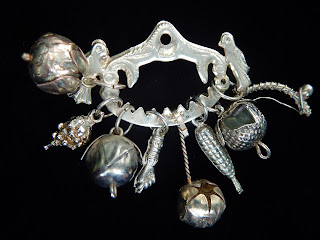Vintage History of Ireland Irish Storyteller Celtic Sterling Silver Ingot Pendant
 |
| ayquebella.com |
 |
| ayquebella.com |
 |
| ayquebella.com |
 |
| ayquebella.com |
- Signature Hallmark: MADE IN IRELAND SD .925 and indiscernible hallmarks
- Metal: Sterling Silver
- Finish: Undisturbed, natural patina (may require a light cleaning, if desired)
- Condition: Excellent vintage
- Weight: 9.1 g
- Bale: O-ring
- Measurements: Approx. 2” L x 5/8” W
- Gift box and wrapping may vary.
 |
| ayquebella.com |
FULL DESCRIPTION OF SYMBOLS:
1. St. Patrick - Ireland's patron saint who changed Ireland’s course in the 5th Century, converting the Irish to Christianity.
2. The Round Towers - From the 6th Century onward, Christian monks built the Round Towers as the Irish embraced Christianity. Originally bell-towers, they were soon needed for storage and refuge during invasion.
3. Viking Warrior - From the 9th to the 11th Century, Vikings repeatedly attacked the Irish coast. Defeated by Brian Boru at the Battle of Clontarf in 1014, the Norsemen retained Dublin, Wexford, Waterford, Cork and Limerick.
4. Norman Soldier - The 12th Century invaders were Norman, Flemish and Norman-Welsh, led by Henry Angevin, Henry II of England.
5. Dublin Castle - Built on the order of King John “for the custody of our treasure... the administration of justice and if need be for the defense of the city” between 1204 and 1224. It became the center of Anglo-Normans, and later, English power, provoking hostility from native Irish.
6. King William - Protestant King William defeated his father-in-law, Catholic James II at the Battle of the Boyne in 1690. The victory assured a Protestant ascendancy, lasting for more than two centuries.
7. The Union Jack - In 1800, the Irish Parliament was abolished for direct rule from London. The cross of St. Patrick was added to the Union Jack. The unpopular union was forced through with fears of a French invasion throughout Ireland.
8. The Great Famine - The potato crop failed catastrophically in the 1840s. The London government failed to act and a crippling famine ensued. Over 1 million died and another million scattered around the globe. (Yes, I know...I know..this one leads to many discussions, debates and arguments...)
9. The Emigrant Ship - The Irish were reluctant emigrants before the famine. In the decades after, Irish emigration rose dramatically, with most going to the United States and Canada.
10. The GPO - In 1916, The Republic of Ireland was proclaimed from the General Post Office during the Easter Rising. It was a military failure but the execution of ‘The Rising’ leaders provoked great anger, igniting the War of Independence.
11. Partition - The 1921 treaty ended the War of Independence. Six of Ulster's nine counties became “Northern Ireland,” a province of the UK. The 26 remaining counties became “The Irish Free State” and in 1948 the “The Republic of Ireland.”
12. Domine Quō Vādis - The question mark symbolizes the unknown future of Ireland.



